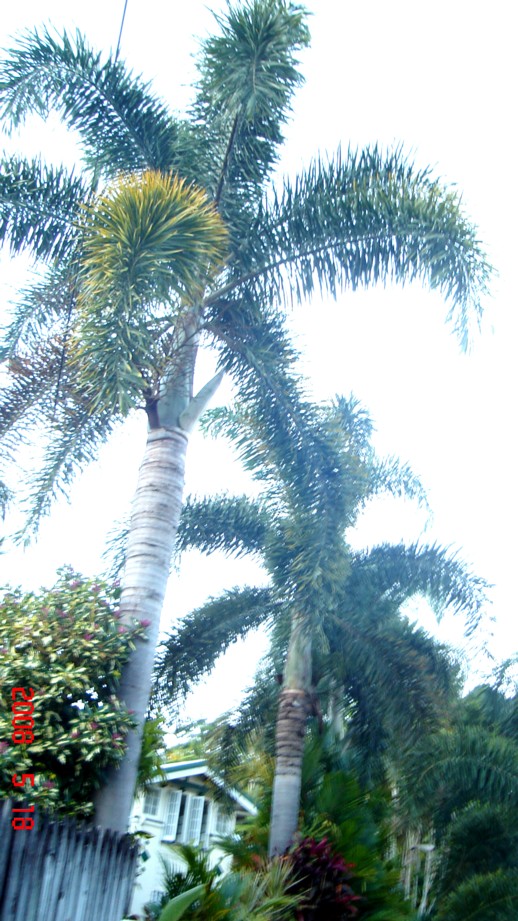- Wodyetia
taxobox

image_caption = "Wodyetia bifurcata"
status = LR/cd
status_system = IUCN2.3
regnum =Plantae
unranked_divisio =Angiosperms
unranked_classis =Monocots
unranked_ordo =Commelinids
ordo =Arecales
familia =Arecaceae
genus = "Wodyetia"
species = "W. bifurcata"
binomial = "Wodyetia bifurcata"
binomial_authority = Irvine|The Foxtail Palm ("Wodyetia bifurcata") is a species of
flowering plant in theArecaceae family [Dowl, J.L. 1998. [http://www.iucnredlist.org/search/details.php/38733/all Wodyetia bifurcata] . [http://www.iucnredlist.org 2006 IUCN Red List of Threatened Species. ] Downloaded on 20 July 2007.]The Palm and Cycads Societies of Australia (PACSOA) describes this Palm as follows:
"Very attractive palm with long (2-3m.) plumose leaves (hence the name 'Foxtail'), and up to 10m tall with a grey trunk. It produces large (about the size of a duck egg) orange fruit" [http://www.pacsoa.org.au/palms/Wodyetia/bifurcata.html Palm and Cycad Societies of Australia webpage on Wodyetia bifurcata] Accessed 3 May 2008]
Etymology
Most of the world were unaware of the existence of this 'spectacular' palm until 1978, when an Aboriginal man brought it to botanists and the world's attention [http://www.usbg.gov/plant-collections/conservation/upload/wodyetia%20bifurcata.pdf usbg.gov plant-collections] Accessed 3 May 2008]
The Aboriginal name of that Aboriginal man has been recorded as being "Wodyeti", thus the genus name for this Australian endemic species "Wodyetia".
Ecology and Habitat
The Foxtail Palm is endemic to a very small part of
Australia , originally decorating the boulder strewn, exposed gravel hills of theCape Melville range, wholly within theCape Melville National Park .The area has been recognised for it's rich
biocultural diversity , having long and intense Aboriginal associations and a rich biodiversity [http://www.epa.qld.gov.au/parks_and_forests/find_a_park_or_forest/cape_melville_national_park/cape_melville_national_park__nature_culture_and_history/ Queensland National Parks and Wildlife Service's (2008) Cape Melville National Park - Nature, culture and history webpage] Accessed 4 May 2008] .In addition to being a habitat for Foxtail Palms, the Melville Range is a habitat for animals such as the Godman's rock-wallaby (
Petrogale godmani ), the tropical ring-tailed gecko (Cyrtodactylus louisiadensi) plus endemic frogs and lizards such as the Cape Melville boulder skink (Cryptoblepharus fuhni), the Melville Range treefrog (Litoria andiirrmalin ) and the Cape Melville boulderfrog (Cophixalus zweifeli ).Distribution
When, in 1978, this palm was first identified, named, and revealed to the world, it was endemic only to a very small part of
Australia . being theCape Melville range, within theCape Melville National Park . It was classed as a rare palm, both withinQueensland , and on theIUCN 's Red List of Threatened Species.After it became known to the world, the Foxtail Palm's seeds were so highly sought after that a thriving blackmarket trade formed, with illegal collectors nearly decimating the in situ populations, but ultimately resulting in the palm becoming widely distributed across the world, fruiting in the many tens of thousands, being progressively planted out as one of the "world's most popular" palms.
External links
* [http://www.iucnredlist.org/search/details.php/38733/all IUCN Redlist of Threatened Species entry for Wodyetic bifurcata] Accessed 3 May 2008
* [http://www.pacsoa.org.au/palms/Wodyetia/bifurcata.html Palm and Cycad Societies of Australia webpage on Wodyetia bifurcata] Accessed 3 May 2008
* [http://palmguide.org/FTBG_images/large/92252G_2004061667272.jpgPalmguide.org picture of Wodyetia bifurcata]References
Wikimedia Foundation. 2010.
